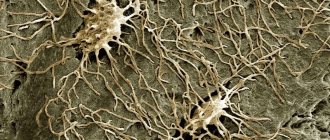Allergic laryngeal edema is a pathological condition characterized by inflammation of the mucous tissues of the larynx and narrowing of its lumen (stenosis). It occurs due to the body’s contact with factors hostile to it – allergens.
Author:
- Sadykhov Rahim Agalarovich
ENT pathology expert
2.45 (Votes: 38)
Allergic laryngeal edema is a pathological condition characterized by inflammation of the mucous tissues of the larynx and narrowing of its lumen (stenosis). It occurs due to the body’s contact with factors hostile to it – allergens, which cause a negative immune reaction. The main danger of edema is depression of respiratory function. As the lumen of the larynx narrows, breathing becomes difficult, which provokes oxygen deficiency, which is life-threatening.
What is the larynx?
Many people, even those who know anatomy well, may confuse the larynx with the pharynx, throat, or trachea. The larynx is not a separate organ, but a section of the respiratory system that is especially important and very complex in structure.
The larynx is located in the upper part of the trachea, at the level of 4-6 cervical vertebrae. Its position is ensured by its attachment to the thyrohyoid gland and connection with the hyoid bone. Air passing through the larynx forms vibrations in a person’s vocal cords - from here the human voice is born1.
The structure of the larynx includes a combination of many cartilages (epiglottis, thyroid cartilage, cricoid cartilage and others) with muscle joints and ligaments. Inside, the larynx is covered with a mucous membrane, which is so loved by viruses and various bacterial infections.
Prevention of laryngitis
To prevent laryngitis, it is necessary to harden the body, adhere to a healthy lifestyle, pay sufficient attention to physical activity, avoid hypothermia, dress warmly in cold weather and try to talk less on the street. Timely treatment (and prevention) of colds, as well as inflammatory pathologies of the nose and sinuses, is of considerable importance.
Representatives of professions associated with constant strain on the ligaments should adhere to the voice mode (outside of work, talk as little as possible and do it quietly, and also give the ligaments a rest, that is, remain silent). It is also recommended that such people be regularly observed by a phoniatrist.
It is recommended to keep your home clean (since dust can trigger the development of laryngitis) and sufficient air humidity. An air purifier and humidifier will help you with this.
People working in unfavorable conditions are recommended to take preventive inhalations after finishing the working day to cleanse the mucous membrane of the respiratory tract from harmful substances (in this regard, you need to consult a doctor who will suggest the optimal method and medicinal composition).
Causes of laryngeal edema
The mechanics of edema are simple. In the larynx, as a result of one or another effect, there is a sharp or gradual increase in the volume of mucous tissue, which begins to block the lumen of the respiratory tract. In medicine, this condition is called laryngeal stenosis2.
The reasons that can cause swelling of the larynx are extremely varied. It is generally accepted to divide laryngeal edema into two main types - inflammatory and non-inflammatory.
Pathologies and inflammatory diseases that provoke laryngeal edema include:
- Viral and bacterial infections - acute tonsillitis (tonsillitis), chronic tonsillitis, pharyngitis, tracheitis, inflammatory diseases of the oral cavity, abscess and most diseases of the ARVI group.
- Chronic infectious diseases - tuberculosis, syphilis and others.
- Acute infectious diseases - scarlet fever, measles, typhus.
- Vasomotor edema and allergic edema of the larynx. The cause is an allergy familiar to many, which provokes inflammation of the mucous membrane of the larynx. The laryngeal mucosa is very sensitive to the influence of allergens and the reaction in the form of swelling is quite common.
Non-inflammatory causes are no less diverse; these include swelling due to mechanical, chemical (toxic) or thermal effects. Burns from food that is too hot or cold is a common cause, especially in children. Swelling can also be caused by a foreign object in the throat or a piece of food.
In addition to the nature, inflammatory or non-inflammatory, there are two forms of edema - limited and diffuse (spill). With limited swelling, a person may not even be aware of the condition of the larynx, he is not bothered by severe pain and can breathe freely. Diffuse edema is characterized by severe narrowing of the larynx and damage to a large area of mucous tissue; breathing is almost always difficult2.
Complications of tracheitis
Tracheitis, the cause of which is considered to be an infection, can be complicated by the spread of the inflammatory process and the occurrence of bronchitis or pneumonia. Patients experience symptoms such as increased body temperature, hard breathing in the lungs, increased coughing attacks, and wet and dry wheezing. If a patient develops pneumonia, their health may deteriorate significantly and pain may appear during breathing.
A long-term inflammatory process in the trachea, as well as pathological changes in the mucous membrane, can lead to the appearance of malignant or benign neoplasms. If a patient has bronchitis due to exposure to any allergens on the body, then further exposure to them can cause bronchial asthma, which is characterized by shortness of breath and suffocation.
Main symptoms of laryngeal edema
Despite the fact that in most cases laryngeal edema itself is a symptom, it is not always possible to detect it promptly. Professional medical diagnostics or special signs characteristic of laryngeal edema3 come to the rescue:
- Severe cough, most often of the “barking” type;
- Hoarseness, loss or severe changes in voice - given that the human voice apparatus is located in the larynx, this is a quite obvious sign;
- Gradual progression of suffocation, breathing becomes difficult.
Laryngeal edema does not always develop slowly and unnoticeably. In rare cases, an emergency condition occurs in which swelling occurs immediately (laryngospasm). In such a case, the symptoms of laryngeal edema will be pronounced:
- The appearance of cyanosis on the face;
- Severe suffocation and oxygen starvation, complete asphyxia is possible.
Additional signs of the development of laryngeal edema may include more general symptoms that are characteristic of many other diseases:
- Temperature increase;
- Feeling of a foreign object in the throat, while the exact position cannot be determined;
- Discomfort and pain in the larynx area, especially when swallowing;
- Intoxication of the body - general weakness, nausea, headaches, muscle pain, etc.;
- Shortness of breath, even at rest.
Swelling of the throat with sore throat
International medical practice classifies inflammation of the tonsils as acute tonsillitis. However, the more familiar name for us “angina” (translated from Latin means “squeeze, strangle”), quite accurately describes the ongoing pathological process. Swelling of the throat during sore throat partially blocks the airways, and the patient begins to choke. This rather serious local complication is accompanied by:
- stridor (difficulty noisy breathing);
- pain when swallowing in the absence of cough;
- swelling of the neck, change in color of the skin of the face (pallor, and then cyanosis).
Diagnosis of laryngeal edema
In most cases, an experienced doctor (otolaryngologist, pulmonologist or even a therapist) can easily diagnose laryngeal edema. A visual examination or laryngoscopy will give an understanding of the condition of the sick person’s larynx. Endoscopy will show the most complete condition of the larynx. With edema, redness is almost always present, as is swelling of the laryngeal mucosa, and the glottis will be noticeably narrower4.
However, it is not recommended to diagnose this condition yourself. A doctor should examine it, since complications or severe forms are possible, in which there is a risk of suffocation, and swelling can directly indicate the development of a dangerous disease.
How to relieve throat swelling at home?
It must be remembered that at the first symptoms of throat swelling, urgent medical attention is needed. The likelihood of rapid development of the condition requires emergency medical intervention to save the patient’s life. In such a situation, the problem of how to relieve throat swelling at home comes down to providing emergency assistance before the ambulance arrives:
- try to calm the patient, as a panic state increases swelling;
- try to provide access to air (unbutton your collar, remove your tie, if possible, increase the humidity of the room);
- if there is absolute confidence in the allergic nature of the swelling of the throat, then give the patient an antihistamine.
First aid and treatment of laryngeal edema
If swelling occurs that causes immediate breathing problems, you need to act quickly. Man's main enemy is panic. In this case, in addition to promptly calling doctors, first aid should be provided.
The first step is to free the chest of an adult or child from any load, including clothing. If you are in a panic state, you should try to calm the person down. Next, provide access to fresh air, and, if possible, reduce the ambient temperature. If the cause of swelling is known, for example the effect of a certain allergen, then it should be blocked immediately. Spraying cool water on your face will help relieve the condition5.
Most often, a timely visit to a doctor solves everything, and treatment of laryngeal edema is as effective as possible. Having established the cause of the swelling, the doctor prescribes medications. Depending on the reasons, anti-inflammatory and antiallergic medications (antihistamines) are used. If the cause is a viral or bacterial infection, immunomodulators and antibiotics may be prescribed for the most serious bacterial infection. In case of sharp progression of edema and suffocation, drug therapy is carried out based on antispasmodic and hormonal drugs.
A person with edema should remain completely at rest, eat liquid foods and drink enough water. It is not recommended to talk a lot - you need to minimize all irritating factors. In the most serious cases, surgery may be required.
As you know, disease is easier to prevent. The same applies to laryngeal edema. The most common causes of edema are acute respiratory diseases. Viruses or bacteria enter the mucous membranes of the larynx and begin to act insidiously. Often, this happens due to insufficient strength of local and general immunity.
To maintain local immunity, doctors may prescribe immunostimulating agents. One of these drugs, but with interesting features, is a drug based on bacterial lysates, Imudon®. The effect of the drug is associated with an increase in the number of cells aimed at fighting bacteria and viruses. Imudon® has direct indications for pharyngitis and chronic tonsillitis6.
Imudon® is presented in the form of lozenges with a pleasant taste, which is especially important for children. The drug can be used from three years of age7. This form allows the drug to act at the very site of inflammation and directly influence local immunity.
Instructions
Learn more
Developed with support from Abbott to improve patient health awareness. The information in the material is not a substitute for healthcare advice. Contact your doctor. 1. Babiyak, V. Otorhinolaryngology / V.I. Babiyak, I.B. Vyacheslav // “Peter” - Study guide, manual - 2009 - Volume 2 - P. 13-30. 2. Soldatsky, Yu. Diseases of the larynx / Yu.L. Soldatsky // Pediatric pharmacology - 2008 - No. 2 - Volume 5 - P. 20-25. 3. Trukhan, D. Respiratory diseases. Tutorial. / D.I. Trukhan, I.A. Viktorova // SpetsLit – 2013 – P. 175. 4. Svistushkin, V. Application of contact endoscopy in the diagnosis of diseases of the larynx / V.M. Svistushkin, N.D. Chuchueva // RMJ – 2015 – No. 23 – P.1406-1408. 5. Gurov, A. Local therapy of inflammatory diseases of the pharynx / A.V. Gurov, M.A. Yushkina // RMJ – 2022 – No. 11 – P. 792-796. 6. Luchikhin, L. Efficacy of the drug Imudon® in the treatment of patients with acute and chronic inflammatory diseases of the pharynx / L. A. Luchikhin [et al.] // Bulletin of Otorhinolaryngology - 2001 - No. 3. – pp. 62-64. 7. Instructions for medical use of the drug Imudon® lozenges dated 07/02/2018.
RUS2157722 from 08/19/2020
4.Treatment
Considering the above, it remains only to repeat: epiglottitis is a life-threatening emergency, and at the first sign, an ambulance should be called immediately. In young children, epiglottitis often begins suddenly, in the evening or at night, when the child has already fallen asleep - and wakes up with a high temperature and difficulty breathing; A lot depends on the quick, adequate reaction of parents in this situation. In the absence of medical care, complete blockage of the airways with epiglottitis can occur within 2-5 hours from the moment the first symptoms appear.
The patient is immediately hospitalized, and respiratory failure is treated in the intensive care unit. Under powerful antibacterial cover, artificial ventilation of the lungs is used, measures are taken for detoxification, prevention of pulmonary edema, prevention of sepsis, intracranial complications, and multiple organ failure. According to indications, immunocorrectors, anti-inflammatory and other drugs are prescribed. During the rehabilitation period, antibiotic prophylaxis of reinfection is continued (staying in an isolated box is indicated), in addition, physiotherapy is prescribed.










